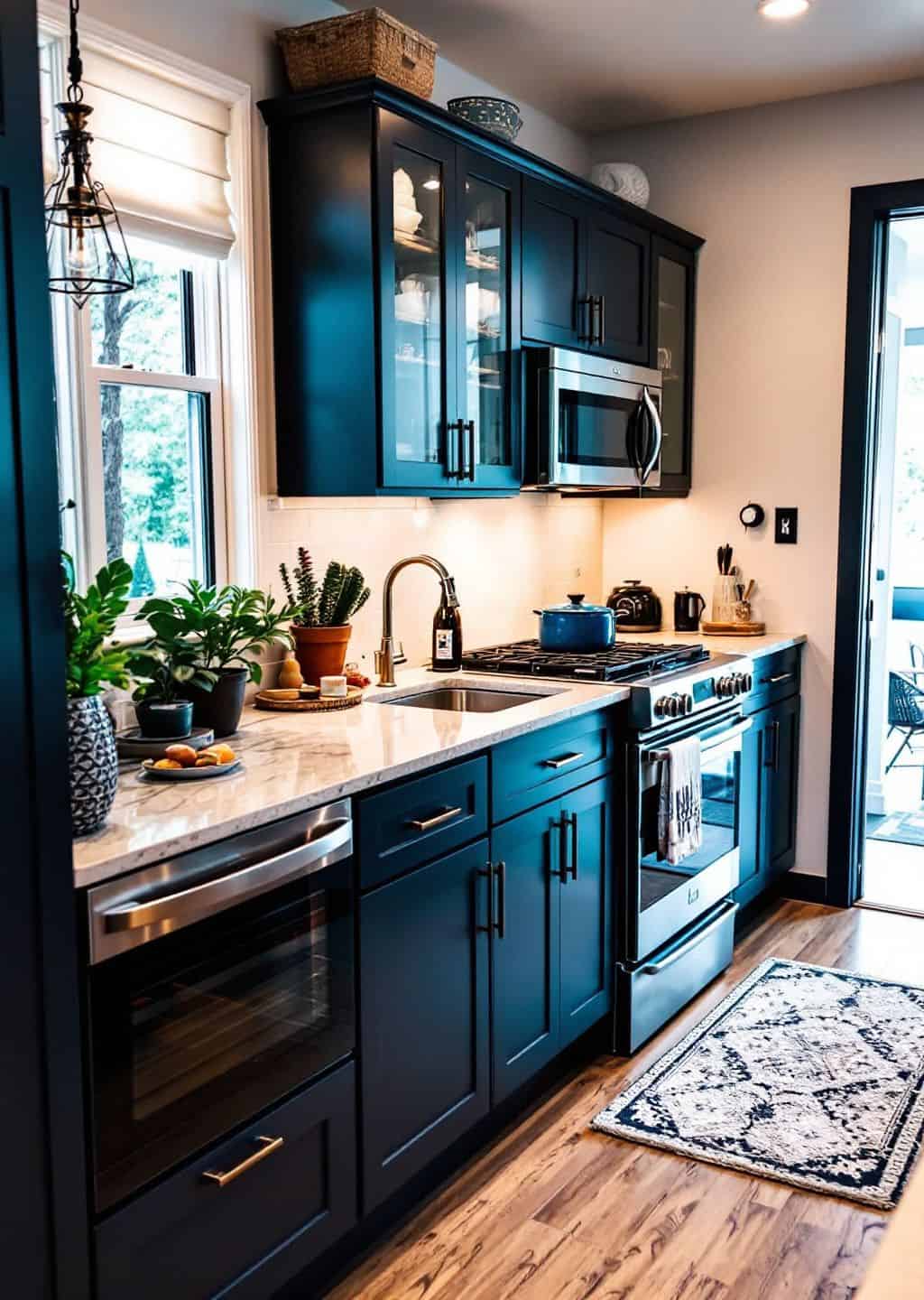Grease is every kitchen’s sneakiest villain. At first, it’s invisible—a mist that floats up from cooking and slowly lands on your cabinets.
But over time, it thickens into a sticky film that grabs dust, darkens wood, and seems impossible to wipe away.
The good news?
In this guide, you’ll discover proven ways to clean old grease and learn how to keep it from building up again.
Why Is Grease So Hard to Clean?
Grease buildup isn’t just oil. It’s oil plus dust plus heat. When airborne fat particles from cooking settle on cabinets, they oxidize and harden. Add dust into the mix, and you’ve got a sticky, yellowish layer that resists water.
That’s why just wiping with a damp cloth doesn’t work—you need something that:
- Breaks down oil molecules (like dish soap or vinegar).
- Softens the hardened layer (with heat or time).
- Provides gentle abrasion (like baking soda or a sponge).
The key is removing grease without stripping paint or damaging wood grain.
Gather Your Cleaning Arsenal

Before diving in, here are the basic supplies you’ll want nearby:
- Mild dish soap (like Dawn) — best all-around degreaser.
- White vinegar — natural grease cutter, though use carefully on wood.
- Baking soda — gentle scrubbing power.
- Microfiber cloths — won’t scratch, absorb more than cotton rags.
- Soft sponge / old toothbrush — to reach grooves and edges.
- Spray bottle — for DIY solutions.
- Optional: Commercial degreaser (Krud Kutter, Simple Green) — for heavy buildup.
Proven Methods to Clean Old Grease from Kitchen Cabinets
1. Dish Soap and Hot Water — The First Line of Defense

Why it works: Dish soap is formulated with surfactants—molecules that latch onto both oil and water. They pull grease off the surface so it can be rinsed away. Combine it with hot water, and you speed up the process by softening hardened oils.
How to do it:
- Mix a few drops of dish soap with 2 cups of hot water.
- Dip a microfiber cloth, wring it out until damp (not soaking).
- Wipe the greasy areas, working in small sections.
- Rinse cloth in clean water, reapply soap solution, and repeat.
- Dry thoroughly with a fresh microfiber cloth.
Pro Tip: Add a splash of vinegar for an extra boost (but not on natural wood).
Warning: Don’t leave cabinets wet for long—wood can warp or swell if soaked.
2. Baking Soda Paste — The Gentle Scrub

Why it works: Baking soda is mildly abrasive and alkaline. It breaks down acidic grime and gives you a safe scrubbing boost without harsh chemicals.
How to do it:
- Mix 2 tablespoons of baking soda with 1 tablespoon of warm water to form a paste.
- Apply directly to stubborn greasy spots.
- Let sit for 5–10 minutes.
- Scrub gently with a toothbrush or sponge in circular motions.
- Wipe clean with a damp cloth, then dry.
Pro Tip: For an extra boost, replace the water with lemon juice. The citric acid plus baking soda works like a fizzing scrub.
Warning: Avoid over-scrubbing painted or glossy cabinets—baking soda can dull the finish if you use too much force.
3. Vinegar Spray — Natural, Fast, and Cheap

Why it works: Vinegar’s acetic acid cuts through grease naturally. It dissolves fatty deposits, making them easier to wipe away.
How to do it:
- Mix equal parts white vinegar and warm water in a spray bottle.
- Spray directly onto greasy areas.
- Let sit for 2–3 minutes.
- Wipe with a microfiber cloth, rinsing as needed.
Pro Tip: Add a drop of dish soap for extra power. Or infuse vinegar with lemon peel for a fresher scent.
Warning: Too much vinegar can dull or damage stained wood finishes. Always test in a hidden corner first.
4. Heat + Soap — The Secret Shortcut
Why it works: Grease softens when heated. By applying mild heat first, you make the grease easier to lift with soap instead of scrubbing endlessly.
How to do it:
- Use a hair dryer on a medium setting, or a handheld steamer.
- Warm the greasy patch for 30–60 seconds.
- Immediately wipe with a cloth dipped in hot soapy water.
- Rinse and dry.
Pro Tip: This trick works wonders for cabinet tops, which often have the worst buildup.
Warning: Keep the hair dryer moving to avoid overheating wood or paint. Never steam veneer cabinets—they can warp.
5. The Oil-on-Oil Trick — Counterintuitive but Brilliant

Why it works: Oil dissolves oil. A small amount of vegetable or olive oil can actually soften hardened grease, making it easier to remove with soap afterward.
How to do it:
- Dip a cloth in a teaspoon of cooking oil.
- Rub greasy spots gently until the grime loosens.
- Wipe away residue with a clean paper towel.
- Follow immediately with hot soapy water to remove the oil film.
Pro Tip: Works especially well for cabinet tops where grease has thickened into a tar-like layer.
Warning: Never skip the soap step—otherwise you’ll just replace old grease with new oil.
6. Commercial Degreasers — When DIY Isn’t Enough

Why it works: Commercial degreasers like Krud Kutter, Simple Green, or Murphy’s Oil Soap contain specialized solvents that dissolve hardened oils without sanding or harsh scrubbing.
How to do it:
- Always spot-test in an inconspicuous corner first.
- Spray directly onto greasy areas or apply with a cloth.
- Let it sit for 1–2 minutes (follow label instructions).
- Wipe clean with a damp cloth.
- Dry thoroughly with a microfiber towel.
Pro Tip: Murphy’s Oil Soap is excellent for wood cabinets because it cleans while conditioning the wood. Krud Kutter is more aggressive—perfect for heavy, sticky buildup.
Warning: Avoid degreasers that contain ammonia or bleach—these can discolor wood and paint.
7. Magic Erasers — A Double-Edged Sword

Why it works: Magic Erasers are melamine foam—essentially micro-abrasive sponges that work like ultra-fine sandpaper. They’re effective for sticky grease but can also dull glossy finishes.
How to do it:
- Wet the Magic Eraser lightly and squeeze out excess water.
- Gently rub small grease patches in circular motions.
- Immediately wipe with a damp microfiber cloth.
- Dry thoroughly.
Pro Tip: Reserve Magic Erasers for handles, corners, and edges where grease accumulates most and cabinets are less visible.
Warning: Never scrub entire cabinet doors with a Magic Eraser—it will strip shine or protective coating. Use sparingly.
8. Trisodium Phosphate (TSP) — Heavy-Duty Pre-Paint Cleaner

Why it works: TSP is a strong alkaline cleaner that cuts through years of hardened grease. It’s often used by painters to prepare cabinets before refinishing.
How to do it:
- Mix per package directions (usually 1 tablespoon TSP to 1 quart water).
- Dip a sponge, wring it out, and wipe cabinet surfaces.
- Rinse thoroughly with clean water—twice if possible.
- Dry completely with microfiber cloths.
Pro Tip: Use TSP only if you plan to repaint or refinish cabinets, or if all else fails.
Warning: TSP is harsh—wear gloves, ventilate the room, and never use it on delicate painted or laminate cabinets unless repainting is the goal.
9. Material-Specific Cleaning Advice

Different cabinets react differently to cleaning methods. Here’s what you should know:
Wood Cabinets
- Best cleaners: Dish soap + hot water, Murphy’s Oil Soap.
- Avoid: Undiluted vinegar or strong abrasives.
- After cleaning: Apply a wood conditioner or polish once or twice a year.
Painted Cabinets
- Best cleaners: Dish soap, diluted vinegar, baking soda paste (spot use).
- Avoid: Magic Erasers on large areas; harsh scrubbing.
- After cleaning: Always dry completely to prevent paint chipping.
Laminate Cabinets
- Best cleaners: Dish soap, vinegar spray, commercial degreasers.
- Avoid: Abrasive scrubs (baking soda can scratch plastic veneer).
- After cleaning: Buff with microfiber for a streak-free finish.
10. Preventing Future Grease Buildup

Once you’ve restored your cabinets, prevention is everything. A few simple habits can save hours of scrubbing later.
- Wipe weekly: Do a quick once-over with warm soapy water once a week.
- Use your range hood: Always turn on the exhaust fan while cooking with oil.
- Splatter protection: A mesh splatter screen keeps oil from flying out of pans.
- Line cabinet tops: Place wax paper or removable shelf liners on top of cabinets. Swap them every few months.
- Cook with lids: Even loosely covering pans reduces airborne grease.
Quick Recipe Reference
Here’s a cheat sheet you can print or save:
| Grease Problem | Best Fix | Notes |
|---|---|---|
| Light daily grease | Dish soap + hot water | Quick weekly wipe |
| Sticky patches | Baking soda paste | Gentle scrub |
| Eco-friendly cleaning | Vinegar spray | Dilute well; avoid raw wood |
| Thick buildup | Heat + soap | Hair dryer trick |
| Heavy grease | Krud Kutter / Murphy’s Oil Soap | Spot test first |
| Pre-paint prep | TSP solution | Wear gloves, ventilate |
Final Takeaway
Cleaning old grease off kitchen cabinets doesn’t have to be overwhelming. Start with gentle cleaners like dish soap and baking soda, escalate to vinegar and heat, and only use commercial degreasers or TSP when buildup is severe.
The real secret is prevention—small weekly wipe-downs keep grease from ever becoming a problem again.
I’m Anastasios Moulios, co-founder of DIY Cozy Living. I enjoy finding creative, practical ways to make small spaces feel warm, stylish, and lived-in — whether it’s a camper, a backyard, or a cozy room inside. I started this blog with Katerina to share real ideas that make home feel a little more personal and a lot more comfortable.



